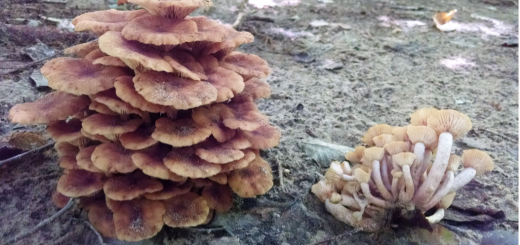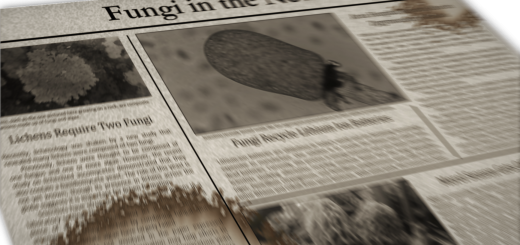#039: Mushroom Morphology: Crust Fungi
This is a broad group of fungi that includes all basidiomycete mushrooms with an exposed spore surface that is smooth or mostly smooth. This group excludes all mushrooms that may be placed into the other morphological groups that I have described previously as well as all lichenized fungi. For example, many chanterelles and corals have a mostly smooth hymenium but are not included in the crust fungi. There are also a number of ascomycetes that fit this description, although they are usually not included at all in field guides. These ascos tend to have small dots or pimples where the spores are released, whereas crust fungi do not have such a distinction. Crust-like ascos also tend to be harder than their basidiomycete counterparts, making microscopic examination somewhat difficult.
Crust fungi, also known as Parchment or Corticioid fungi, are so named because they are often found covering the surface of their substrate like a crust. I will describe a few examples of crust fungi so that you can get a feel for the diversity of this group. One fungus that displays the crust morphology quite well is Terana caerulea, commonly known as the “Cobalt Crust Fungus” or “Velvet Blue Spread.” This wood-decay fungus produces fruiting bodies that are flush against the substrate (resupinate) and extend outward from a central point. When moist, this mushroom is a striking blue, making it very fun to find. One of the most common crust fungi is the wood-decaying Stereum complicatum. It produces fruiting bodies that are mostly flat against its substrate. The top edge of the mushroom is often folded off of the substrate (reflexed) so that spores from the upper surface can fall straight to the ground (and hopefully be picked up by wind currents mid-drop). This small change in morphology is sometimes known as “parchment” morphology, rather than as “crust” morphology. S. complicatum can often be seen as an orange, reflexed crust fungus covering sticks or areas of logs. Not all crust fungi produce fruiting bodies that are flat against the surface. The fungus Stereum ostrea produces bracket-shaped mushrooms with rings of color that make it look very much like Turkey Tail mushrooms. Commonly known as the “False Turkey Tail,” S. ostrea can be differentiated from the Turkey Tail (Trametes versicolor) fairly easily. S. ostrea is a crust fungus and therefore is smooth underneath, unlike T. versicolor, which has pores. Another fungus that does not look like a crust fungus upon first glance is Phlebia incarnata. This fungus produces medium-sized, pinkish brackets that are fleshier than most crust fungi. Its bumpy to wrinkled spore surface is also unusual for a crust fungus, but it is not quite poroid enough to be considered a polypore. Other crust fungi produce small, cushion-shaped bumps instead of fruiting from a single point. One of my favorite crust fungi with this morphology is Xylobolus frustulatus. It produces flattened, white bumps that press up against each other, giving the surface a mosaic-like appearance. The strangest crust fungi are those that produce small, cup-shaped mushrooms*. Species in the genus Maireina are an example of fungi that produce this “cyphelloid” morphology.
You will most commonly find crust fungi fruiting from dead wood, although this morphological group exploits a number of different ecological niches. All of the fungi I mention above are saprobic wood-decay fungi. Their mushrooms can be found year-round, only releasing spores when conditions are favorable (moist and not too cold). There are numerous other crust fungi that are parasitic or even mycorrhizal. A good (but not perfect) way to differentiate ecology is to simply look at the substrate. If the substrate is dead wood, your crust is saprobic. If the substrate is alive, your crust is parasitic. If your fungus is on the ground and not clearly attached to any detritus, it could be mycorrhizal. Most fungal classes contain species with a crust morphology. Because the crust fungi are widely distributed among families within the Basidiomycota, this morphological group is polyphyletic and does not represent a shared ancestry.
* As far as I know, these are the only cup-shaped basidiomycetes (excluding the gasteroid basidiomycetes like the Bird’s Nest fungi). Basidiomycetes do not have forcible spore discharge, so the cup morphology seems like an inefficient way for them to release their spores. However, these fungi seem to make it work somehow.
See Further:
http://www.mushroomexpert.com/crusts.html (click the links for more info on specific crusts)
http://website.nbm-mnb.ca/mycologywebpages/NaturalHistoryOfFungi/CorticioidAndStereoidFungi.html
http://www.loyno.edu/lucec/natural-history-writings/cobalt-crust-terana-caerulea-lovely-fungus (Terana caerulea is not included on the MushroomExpert.com page)
http://www.mushroomexpert.com/taxonomy.html (in case you want to see how a specific crust fungus fits into the fungal phylogeny)









![#011: Characteristics of Kingdom Fungi [Archived]](https://www.fungusfactfriday.com/wp-content/themes/hueman/assets/front/img/thumb-small-empty.png)

1 Response
[…] It’s very common, it lives on rotting wood and it also likes to create rotting wood, says FungusFactFriday.com. This branch in our yard is soon to be a […]